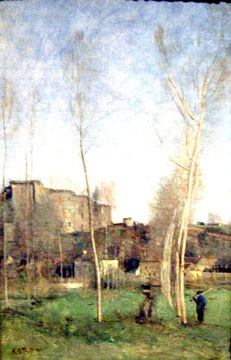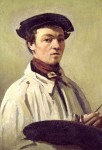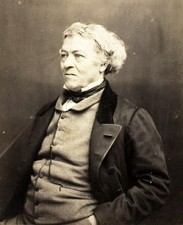
Jean Baptiste Camille Corot
French, 1796-1875
The Glacis of a Ruined Castle-Fort, 1855-1865
oil on canvas
14 1/2 x 9 1/4 in.
SBMA, Gift of the A.S. Clegg Family in celebration of the Museum's Fiftieth Anniversary
1991.89.1

Jean-Baptiste-Camille Corot, Self Portrait, c.1840, Galleria Degli Uffizi, Florence, Italy
“Corot’s figures may not be so well known as his landscapes, but that doesn’t mean that he didn’t make them. For that matter, in Corot every tree-trunk is drawn and modelled with attention and love as though it were a figure.”
- Vincent to Theo, Etten, Friday, August 26, 1881
“Beauty in art is truth bathed in an impression received from nature. I am struck upon seeing a certain place. While I strive for conscientious imitation, I yet never for an instant lose the emotion that has taken hold of me.”
- Jean-Baptiste-Camille Corot
RESEARCH PAPER
This small landscape by Corot in the Santa Barbara Museum of Art is representative of much of Corot’s work, his particular appeal, and his place in nineteenth-century French painting. Corot’s long life and career stretched between the ideals of the early nineteenth-century Romantic and Realistic Movements (particularly demonstrated by Courbet in the 1850’s) while also showing the continuing influence of past traditions as promulgated by the French Academicians. Many art historians see Corot as an essential step leading to the Impressionists. For example, Francois Mathey states, “The Impressionists [are] successors of Delacroix, Courbet, and Corot.”
Training as an artist in the 1820’s, Corot was, and remained, particularly influenced by the Romanatic Movement of the first quarter of the nineteenth century as well as by the Classicists” traditions. His first lessons were from a painter named Michallon in 1822, and these were indeed seminal. Corot is quoted as saying later; “I painted my first landscape direct from nature at Arceuil under the eye of Michallon, whose only advice was to paint with scrupulous care everything that I saw before me.” And then he studied with Michallon’s teacher, Bertin. These teachers, and Corot, accepted the taste and “rules” of the time: landscapes were considered an inferior endeavor, and could only be made acceptable to the standards of the Academy and the Salon shows by emulating the traditions established in the seventeenth century by Poussin and Claude: panoramic views populated by idealized historical or mythological figures, and stately buildings or ruins, as well as by smoothly shaped and finished trees, hills, rocks, bodies of water, skies and clouds.
In contrast, the Romantic Movement “began to exalt actual, personal experience” of nature, leading to the plein air studies of Corot and his contemporaries. However, for a long time, Corot’s outdoor studies remained just that: he kept them for his own pleasure, and transformed them in his studio into finished, “acceptable” paintings of the time for exhibition and sale. Still, whether it was a study or would end up as a finished painting piece for the Salon, Corot had found his passion. As early as 1826, he wrote from Italy, “All I really want to do in life…is to paint landscapes.” And he continued to do so until his death in 1875.
Although Corot supported the Impressionist Movement, and was admired by many of the young artists who were to become a part of it, he did not identify with them. Nonetheless, some of the very well known individuals in the movement were his pupils, notably Pissarro (from 1855) and Berthe Morisot.
Corot was successful during his life with his academic/Salon pictures; now it is his outdoor studies that are admired. In the Salon of 1840, The Flight into Egypt was hung in the Salon Carre, and he sold another work to the state for the first time. Reviewing the Salon of 1845, Baudelaire called him “…the head of the modern school of landscape” and in 1846, Corot was awarded the Legion of Honour. By the early 1850’s dealers and collectors were interested in obtaining his work. The landscape we are considering here, then, was done after his reputation was established, and his landscape studies were also becoming popular, especially with an American audience.
For the sake of relative brevity, I will refer to this painting as Chateau in the following discussion. It pictures “the remains of the Gothic Castle at Ferte-Milon, which was built on the ruins of an older castle by Louis d’Orleans, brother of Charles VI, during the late fourteenth century…it was partially destroyed by subsequent civil wars.” Corot visited this area in one of his annual summer painting expeditions in about 1860.
Certainly the subject of old structures and ruins was popular with the eighteenth-century Classicists, and Corot make many such studies during his trips to Italy ion the 1820’s. Ruined Gothic structures perhaps fit even better with the values of the Romantic Movement, emphasizing the passage of time and the transitory nature of man and his works. However, the ruined aspect of the buildings is not any more apparent here than in his early Italian studies. Corot typically preferred recording a distant scene or grouping, as in this picture.
This distance gave his landscapes the quality of a still-life and led to a simplification of some of the forms—but without sacrificing the “wholeness of form and wholeness of effect.” The rounded sand-colored buildings in the middle ground provide a bulky contrast to the thin and vibrant trees with their graceful curvilinear trunks and branches in the foreground.
Even more than the distant structures, “the figures in Corot’s landscapes are…shadowy beings. They tend to be either plainly theatrical nymphs or dimly realized farm workers.” Chateau has the sketchy farm worker; that it is not a nymph is perhaps another indication of its later date in Corot’s career.
Concordant with Corot’s preference for a “distant grouping of his main subject” is his general treatment of the foreground. Since it is seldom detailed, the distance in the perspective is not specific. In Chateau, the foreground has many variations of greens, and these daubs give an impression of immediacy, but no vegetation is artificially detailed or minutely rendered. The avenue of trees, rather than being particularized or given substance, instead unite the various grounds of the picture, vertically connecting the grassy foreground, the buildings in the middle ground, and the large expanse of sky, which takes up more than half the picture, in the background.
The colors in this painting are fairly subdued, another typical quality of Corot’s work. He was especially concerned with harmony of color and achieving a tonality. “The introduction of white [lead] into all his colours [pigments] …provided him with the equivalent of a key in music, a unifying factor binding the notes of colour into an unassailably harmonious pictorial melody.” Further, Corot wrote, “It has seemed important in preparing a picture (assuming a white canvas) by indicating the most vigorous (dark) values and to continue in an orderly manner up to the lightest. Between the dark and the light, I should allow twenty gradations; thus will your picture be established with order.” According to Keith Roberts, “Corot does not develop through a series of clearly defined stylistic phases. There is only one great caesura, in the 1840’s, when he passed from a bright, rather blond tonality and firm modeling towards a looser handling of paint and a more silvery colour scale.”
Consistent with its later date, Chateau seems to me to demonstrate both the “silvery colour scale,” and the “blond.” The grayish whites graduating to light blues in the sky and clouds, and the black used to indicate the tops of the trees convey at least a pewter tone. But the middle ground buildings and tans in the foreground as well as the tree branches also say “blond,” so perhaps this picture can be seen as having both his favorite tonalities, just as it combines the loose brushstrokes in the foreground with the more modeled buildings in the distance.
As another aspect of his technique, Corot’s brushstrokes also contribute to the “wholeness of effect.” In Chateau, the many variations of greens and browns in the foreground are indicated with short brushstrokes of the different colours. This at first seems to produce a rough texture, but, in fact, the surrounding surface is quite smooth. Unlike the late Impressionists, Corot avoided impasto, removing surface variations of paint with a razor.
Corot’s often quoted advice and belief was “the first two things to study are form and values. These two things are for me the serious bases of art. Color and execution give charm to the work.” Chateau is not only a very good example of some of Corot’s typical techniques for capturing a natural scene, but also, I think, demonstrates the “charm” of so many of his landscapes. There is such lasting charm, in fact, that the standard Corot-joke (from before WWI) is that “of the three thousand pictures that Corot painted…some four thousand are now in America.” Although this comment seems to suggest that there may have been imitators, it is also a reference to the large number of Corot’s known paintings, and to his typical kindness in “loaning” his name to the paintings of his struggling students so they could make some money. I think the Santa Barbara Museum of Art is fortunate to have such a fine example of his work.
Written by Luann Beach, March 29, 2002
Prepared for Web Site by Terri Pagels, February, 2004
Francois Mathey, The Impressionists, trans. By Jean Steinberg (New York, 1961) p. 2.
2. Keith Roberts, Corot (London, 1965), p. 2.
3. As quoted by Roberts, p. 12.
4. For example, see Albert Boime, The Academy and French Painting in the Nineteenth Century (New York, 1971), pp. 46-47.
5. As quoted by Roberts, p. 21.
6. For example, as cited by John Rewald, History of Impressionism (New York, 1946), about Degas, p.24, and Monet’s comments, pp. 37-38.
7. Roberts, p. 24.
8. SBMA Handout, p. l (35).
9. SBMA Handout citing Alfred Robaut’s dating of a Corot notebook, p. l.
10. Handout, p.2 (36).
11. Roberts, pp. 16 and 19.
12. Roberts, p. 31.
13. Roberts, p. 19.
14. As quoted by Roberts, p. 20.
15. Corot, p. 26, cf. Rewald, p. 86: Corot said to Pissarro, “We don’t see in the same way; you see green and I see gray and ‘blond.’ ”
16. Roberts quoting Silvestre, p. 20.
17. Rewald, p. 15.
18. Roberts, p. 7.
19. Dr. Jill Finsten, comment.
POSTSCRIPT
There is some confusion in published literature as to whether Corot was or was not a member of the Barbizon School. This can be resolved by consulting one of our most reliable academic resources, Grove's Dictionary, in which the article on Barbizon does not mention Corot and the article on Corot does not mention Barbizon.
- Jane Turner, Ed., The Dictionary of Art, Macmillan Publishers, 1996, v. 3, pp. 212-213, v. 7, pp. 877-881

Portrait of Corot by Nadar, ca. 1860.
COMMENTS
The current title reflects a use of two languages, both English and French. An earlier French title was Les glacis d’un chateau-fort en ruine ou La Ferte-Milon, and translates in English as The Banks of a Chateau in Ruins or La Ferte-Milon.
